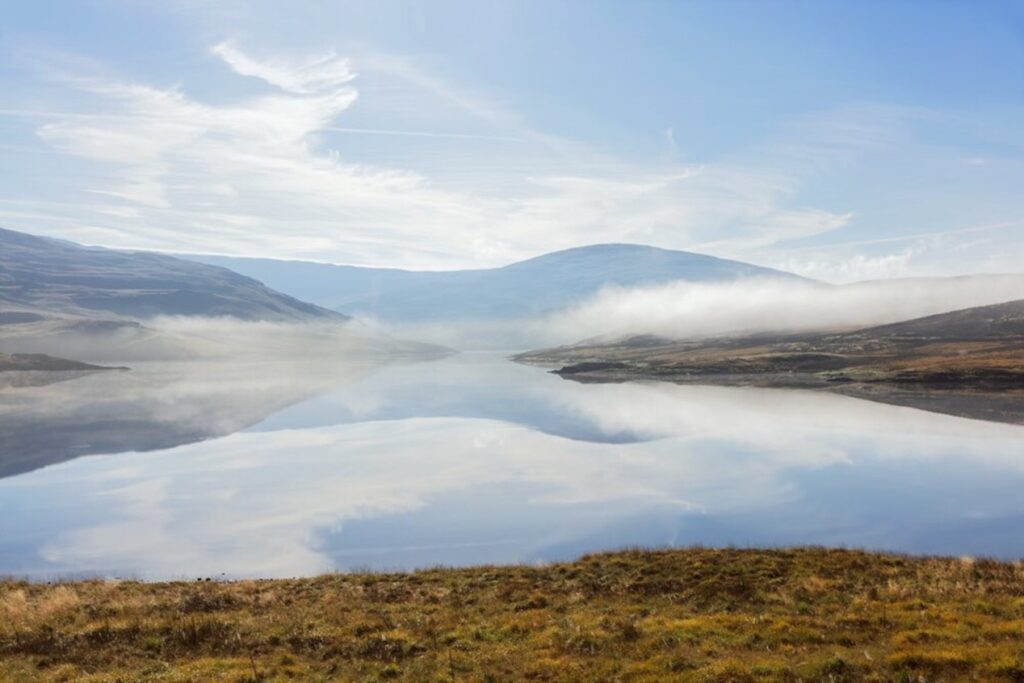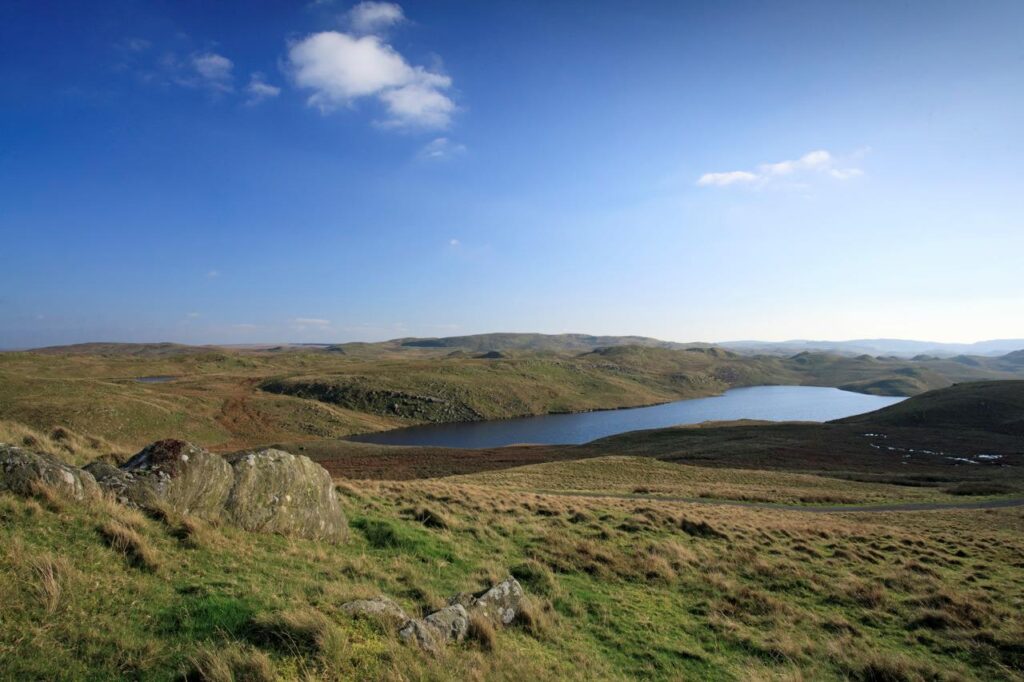Wales, Cymru ! What do those who live here and those who visit see? Different things almost certainly, but for many it is a landscape that is rich with mountains and hills, lakes and rivers and stunning coastlines. They see castles which tell the story of Wales and some which chart the story of Owain Glyndŵr and his rebellion against the English. They see wide open spaces with kites and curlews circling overhead, fields full of sheep, parklands, nature reserves, ancient structures and pathways which go across some of Wales’s most rugged and scenic places. And, when the sky is clear enough, the dark, bible-black, skies areas allow breathtaking views of stars and constellations because they are not hidden by pollution from urban lights. And the valleys, the ones full of Tom Jones’ green, green grass. On some mornings, they hold the magical dragon’s breath which creates a sea of clouds perhaps hiding the the creature that produced them. Myth, magic, stories all make up the culture and language which underpin the landscape. Writers, musicians and artists have all celebrated, continue to celebrate, the landscape, the tir and the people in it.


In the wild land of mid Wales there are vast open spaces with peatland bogs which play a part in supplying drinking water and slowing floodwaters. They can reduce the amount of carbon dioxide going in to the atmosphere and contributing to global warming They are nutrient-rich areas, where wildlife thrives. Peatlands are visited to relax, explore, unwind, and enjoy the the tranquility which few other landscapes can offer. Hikers, birdwatchers, nature watchers are drawn there and help the local economy by spending money on accommodation and food.

Tourism is important to Wales and it is more important than ever now as farmers face more and more challenges and have diversified. Their holiday homes and attractions feed in to other businesses and create an eco system of their own, each depending on the other. And like nature, that eco system is fragile and in danger from outside forces. And these forces are gathering.
Building infrastructure to carry out the spoils from Wales started with the Roman roads like, Sarn Helen, built to carry minerals, especially gold, back to Rome, and perhaps even earlier as the bluestone of the Preseli Hills was transported to Stonehenge. And now, there are people who look at the landscape and don’t see the magic and beauty but see something quite different. They see large, sparsely populated areas and opportunity, opportunity to mine those spaces for profit. Industrialisation and corporate greed has characterised the history of Wales. The coal mines while shaping the economic and industrial landscape, resulted in widespread deforestation, pollution of water sources, and land degradation, impacting ecosystems and the natural landscape. The effect on the land was immense and while they contributed to a sense of identity, of traditions and male voice choirs in the mining villages, ill health and poverty plagued the mining communities. But, the coal fed the growing economy and made millionaires including the Bute family who owned vast tracts of land in the South Wales coalfield, and profited from leasing out mineral rights and investing in infrastructure.
Coal was not the only natural resource that has been used to benefit investors.The villagers of Capel Celyn learnt their homes had been earmarked as the site of a new reservoir to provide water for Liverpool which meant destroying houses in the village near Bala, Gwynedd, and rehousing the villagers elsewhere. In spite of years of protests and marches, all the objections were swept aside by Westminster and Liverpool council and the flooding went ahead sweeping away the last Welsh only speaking community and rallying concern about the erosion of Welsh identity. It is an event which still causes a strong emotional response and which produced the famous graffiti ‘Cofiwch Dryweryn’. Iconic in itself, it inspired similar graffiti works across Wales and is now the inspiration as a campaign icon for a new threat to Wales, more extraction of it resources to be carried off across the border by another Scottish Bute ‘family’ intent on profiting from those resources and building infrastructure.
Years on from the coal mines, the flooding of the valley, a new threat is emerging in mid Wales and one which will destroy the beauty, openness and tranquility which it offers. The land will be subjected to intrusive, human, industrialising activity and will be destroyed in the process along with the communities and individuals who live in these areas. History seems to be in danger of repeating itself. Small, communities with no real voice will see their land and lives mined for profit and flooded with infrastructure which will have no direct benefit to them and which will decimate all the things that are precious. Trees and hedgerows will be chopped down, the winding lines straightened to allow huge lorries to travel down them and the peace and the beauty and the land which sings the songs of its fathers and their fathers will be lost.
The story being told is that all this destruction is for green energy, but Wales already has its own green energy which flows through its beautiful, biodiverse landscapes and the green fuse that ignites its infinite variety. And it doesn’t want to become a poster child for renewables. It wants to make its own independent choices for the how energy is produced from the wind and water and sea, how the raw materials which have been here since the ice receded are used and be part of debates about solutions, not be dictated to by foreign investors and remote political institutions.The headlong rush to populate the landscape with infrastructure to capture the wind, distracts from what will be lost now and for future generations.
For the people who live in it and revisit it time after time, Wales is a land of beauty, of still unspoilt landscapes, of history and heritage and a country that has pride in its language and a native culture that is umbilically connected to the land; somewhere that places a real value on community and all that is local. The threat of the loss of this is immeasurable. To those who want to ransack this environment in the name of saving the planet, well, they see those wide open spaces as the perfect location for building infrastructure to export the energy produced at the expense of this loss. The landscape which is recovering from the scars of the mining, will be re-industrialised with monstrous structures which will blight the beauty, disrupt the flight of the birds, destroy homes and habitats and livelihoods, destroy the valuable eco-systems, and all for profit.
The communities are raising their voices and like their forebears are marching and protesting, but will they be heard over the greenwashing babble of the dire consequences of not allowing these plans to go ahead? Can the voices of those who see the beauty and the magnitude of loss of already depleted wildlife and their habitats, raise their voices loud enough? They started quietly, but they are growing and perhaps by joining together and forming a community of protest, they will grow to a roar that results in not having to mourn more damage to the landscape by humankind and Dylan’s Loud Hill(s) of Wales will be heard roaring in defiance.